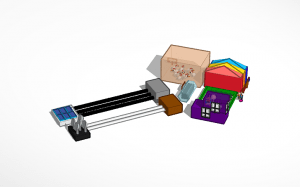Registrations are closed
In the future, to enable astronauts to stay on the Moon for long periods of time, new infrastructures must be developed to overcome important challenges. Such challenges include protection from radiation and meteorites, energy production, the extraction and recycling of water, food production and much more. The Moon Camp Challenge invites students to explore the Moon and decode some of the complexities future astronauts may face.
In Moon Camp Discovery each team’s mission is to 3D design only one component of a Moon Camp using Tinkercad. Teams can choose to design a:
– Lunar lander
– Moon Base
– Lunar rover
– Rocket
– Lunar Orbital Space Station
The design should be adapted to the Moon environment and if possible consider the use of local resources, provide protection and/or living and working facilities for the astronauts.
Moon Camp Discovery is a non-competitive mission for beginners. All teams that submit an entry that complies with the guidelines will receive a participation certificate and their project will be shared on the Moon Camp online platform.
Who can participate?
Participation is open worldwide to students aged up to 19 years old. Moon Camp Discovery is recommended for students aged 6 to 14 years old. Participating students must be supported by a teacher, educator or parent.
Discovery Projects Gallery 2020-2021
Below you can find some of the Moon Camp Discovery projects. For more projects visit the Moon Camp Discovery project gallery.
Team: Juno
Guadalcacín (Cádiz) Spain Category: Moon base
External link for Tinkercad 3D design
1. In this work we are going to present our lunar base model that we have devised.
Our base would be of a circular shape having 10m of radius thus giving 3141,5m2 and 4188m3 of volume. Our base would be limited by a dome prepared for the moon conditions that would cover our work area.
- Problems and solutions of the lunar base.
- Solar radiation.
To deal with the problem of solar radiation we choose to cover the outer part of our dome with translucent photovoltaic cells that reverse solar radiation.
- In the absence of a lunar atmosphere within our capsule, the bases that make up the Earth’s atmosphere will be introduced. Another problem related to the gaseous layer lacking the moon is also the lack of atmospheric pressure that has a simple solution. Based on the law of ideal gases we would only have to introduce the amount of moles of gases sufficient for the interior of the capsule to have an environment of pressures similar to those of the earth.
Pv=nRT n= Pv/Rt n= (1atm*2094000 L)/(0,082 (atm*L)/(mol*K)*298K ) n=85693 mol
For an atmosphere similar to that of the Earth there would be 80% of N2, which would be 68554.4 mol, and another 20% of O2, 17138.6.
To get the O2 would have in the base a factory of O2 constituted by plankton pools. This is because it has a higher production of O2 consuming less resources and space.
- Energy
To obtain energy on our lunar base we will use two methods.
- Solar panels
We will use solar panels similar to those present on Earth but adapted to typical lunar environments.
To this we have to add an inconvenience, the moments when the Moon is not receiving energy from the Sun.
For this we have our second method of obtaining energy, the electricity-generating pipes.
- Electricity-generating pipes
This invention is based on vacuum pipes, this to annul the resistance of the air to the magnets that will be explained later, in which there is a wire of a conductive material. This wire is covered by a thin film of TECAFLON PTFE (PTFE is one of the most used and important fluoro polymers, and very useful in a wide variety of applications, it is usually preferred for sliding applications and, above all, in environments where the part will be exposed to chemical stress)
To reduce the friction of the wire against the magnet.
Magnets are revolving around the wire, thus producing electricity as stated in Maxwell’s Law of Magnetodynamics (the movement of a magnetic field as a function of a conductive material generates electricity). To increase the efficiency of this method, the magnets are of high power and low mass and driven at high revolutions by a mechanical procedure.
- Feeding
The astronauts’ diet would be based on vegetables, from which they would take the seeds and cuttings to the moon, and on chickens, from which we would take fertilized eggs.
Half of the yard area will be used for food plantations and chicken rearing.
Apatio /2=Alivestock and agriculture=785,375m 2
That area would be allocated a part of it for the installation of areas with land for the growth of plants. And also for raising chickens in a mini pen.
All this would be roofed and illuminated by spotlights that simulate sunlight, to avoid being affected by the different moments of sunlight that occurs on the Moon.
Communication would be common on Earth, based on the use of antennas.
- Illumination
During the moments when the Moon would receive sunlight our base would use it to light up on the outside.
When this is not possible a mechanism would be activated by which our protective dome will also serve to illuminate in the interior areas would use tesla cattle to light, because it gives us more energy efficiency and more waste.
- Gravity
Faced with the problem of gravity the only solution is the constant training of astronauts not to lose their muscle mass.
















